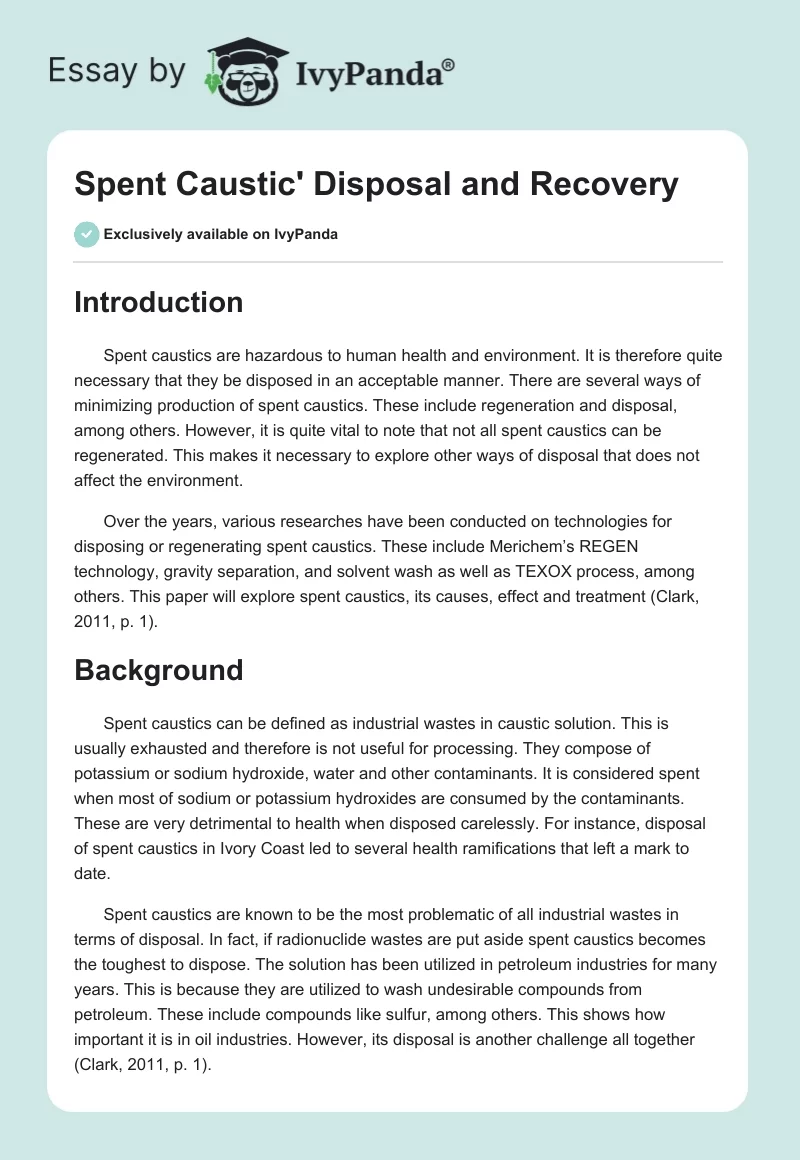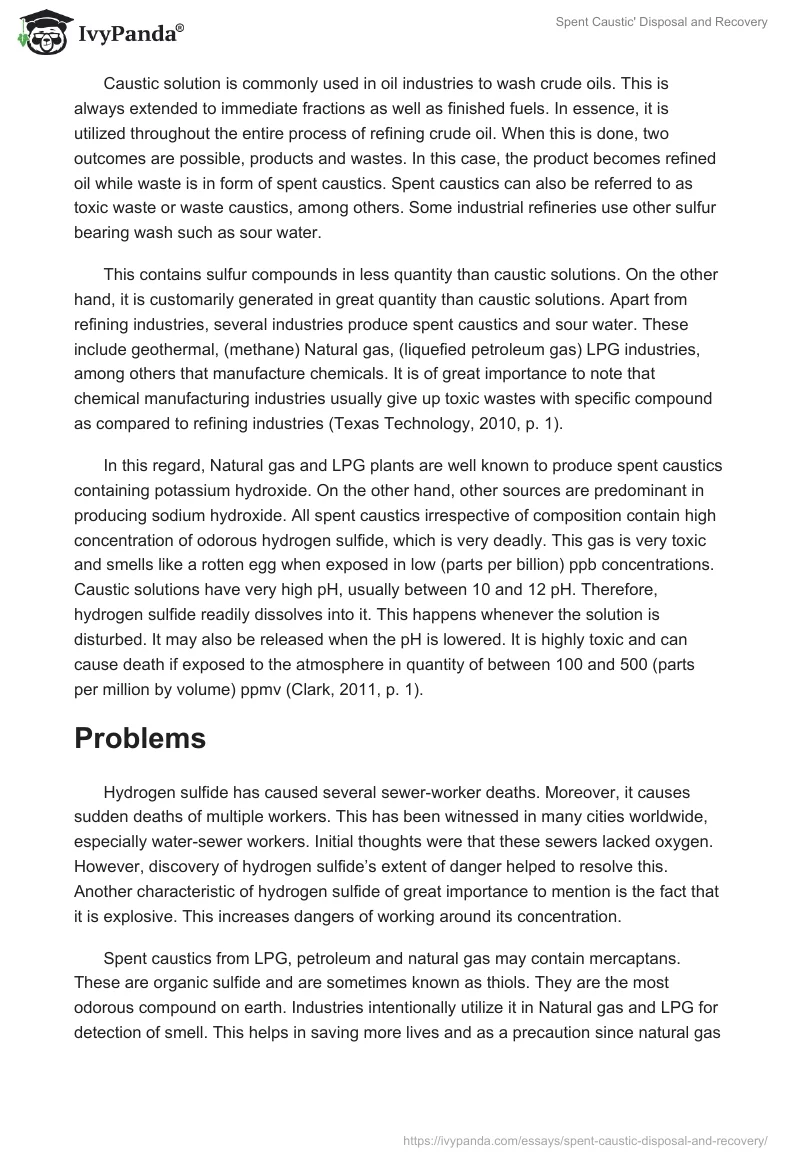Introduction
Spent caustics are hazardous to human health and environment. It is therefore quite necessary that they be disposed in an acceptable manner. There are several ways of minimizing production of spent caustics. These include regeneration and disposal, among others. However, it is quite vital to note that not all spent caustics can be regenerated. This makes it necessary to explore other ways of disposal that does not affect the environment.
Over the years, various researches have been conducted on technologies for disposing or regenerating spent caustics. These include Merichem’s REGEN technology, gravity separation, and solvent wash as well as TEXOX process, among others. This paper will explore spent caustics, its causes, effect and treatment (Clark, 2011, p. 1).
Background
Spent caustics can be defined as industrial wastes in caustic solution. This is usually exhausted and therefore is not useful for processing. They compose of potassium or sodium hydroxide, water and other contaminants. It is considered spent when most of sodium or potassium hydroxides are consumed by the contaminants. These are very detrimental to health when disposed carelessly. For instance, disposal of spent caustics in Ivory Coast led to several health ramifications that left a mark to date.
Spent caustics are known to be the most problematic of all industrial wastes in terms of disposal. In fact, if radionuclide wastes are put aside spent caustics becomes the toughest to dispose. The solution has been utilized in petroleum industries for many years. This is because they are utilized to wash undesirable compounds from petroleum. These include compounds like sulfur, among others. This shows how important it is in oil industries. However, its disposal is another challenge all together (Clark, 2011, p. 1).
Caustic solution is commonly used in oil industries to wash crude oils. This is always extended to immediate fractions as well as finished fuels. In essence, it is utilized throughout the entire process of refining crude oil. When this is done, two outcomes are possible, products and wastes. In this case, the product becomes refined oil while waste is in form of spent caustics. Spent caustics can also be referred to as toxic waste or waste caustics, among others. Some industrial refineries use other sulfur bearing wash such as sour water.
This contains sulfur compounds in less quantity than caustic solutions. On the other hand, it is customarily generated in great quantity than caustic solutions. Apart from refining industries, several industries produce spent caustics and sour water. These include geothermal, (methane) Natural gas, (liquefied petroleum gas) LPG industries, among others that manufacture chemicals. It is of great importance to note that chemical manufacturing industries usually give up toxic wastes with specific compound as compared to refining industries (Texas Technology, 2010, p. 1).
In this regard, Natural gas and LPG plants are well known to produce spent caustics containing potassium hydroxide. On the other hand, other sources are predominant in producing sodium hydroxide. All spent caustics irrespective of composition contain high concentration of odorous hydrogen sulfide, which is very deadly. This gas is very toxic and smells like a rotten egg when exposed in low (parts per billion) ppb concentrations. Caustic solutions have very high pH, usually between 10 and 12 pH. Therefore, hydrogen sulfide readily dissolves into it. This happens whenever the solution is disturbed. It may also be released when the pH is lowered. It is highly toxic and can cause death if exposed to the atmosphere in quantity of between 100 and 500 (parts per million by volume) ppmv (Clark, 2011, p. 1).
Problems
Hydrogen sulfide has caused several sewer-worker deaths. Moreover, it causes sudden deaths of multiple workers. This has been witnessed in many cities worldwide, especially water-sewer workers. Initial thoughts were that these sewers lacked oxygen. However, discovery of hydrogen sulfide’s extent of danger helped to resolve this. Another characteristic of hydrogen sulfide of great importance to mention is the fact that it is explosive. This increases dangers of working around its concentration.
Spent caustics from LPG, petroleum and natural gas may contain mercaptans. These are organic sulfide and are sometimes known as thiols. They are the most odorous compound on earth. Industries intentionally utilize it in Natural gas and LPG for detection of smell. This helps in saving more lives and as a precaution since natural gas is not odorous. This is the reason behind deodorization of LPG propellants although it makes them quite expensive (Texas Technology, 2010, p. 1).
Spent caustics from refineries also have several compounds, among which include phenol. This compound exhibits various properties, which include toxicity as well as odor. Phenol is so dangerous that exposure to skin area of 64 square inches would cause death. Toxic wastes from refineries are also known to contain cresylates, which is another form of phenol. It belongs to the family group known as phenolics. However, phenols are more toxic than cresylates. They are usually significant to refined fuels as they complete the octane.
It has been noted that some of it partitions in spent caustics. Another spent caustic from refineries is naphthenic. They are partially soluble in toxic wastes and do not increase toxic odor of caustic solution. One of its main impacts in caustic solution is increase in organic carbon. Spent caustics are also found in geothermal industries. However, toxic wastes in geothermal facilities contain fewer sulfides. In addition, very little trace of mercaptans is found (MPR Services, Inc., 2011, p.1).
Causes
Spent caustics are caused by various means. These range from oil refineries to chemical manufacturing industries. Moreover, it is also caused in geothermal industries albeit in small proportions. Caustics solutions are composed of sodium or potassium hydroxide, water and other contaminants. However, when sodium or potassium peroxide is consumed from the solution then whatever remains is known as spent caustic. This is sometimes known as toxic wastes or caustic wastes. In LPG and Natural gas industries, caustic solution is used to wash crude oil.
This consumes the potassium hydroxide leaving sulfide hydroxide. Sulfide hydroxide is odorous and extremely dangerous. These wastes result from processes of chemical manufacturing, caustic cleaning solutions, petroleum sweetening, generation of geothermal power and gas blowdowns, among others. Spent caustics produced from the processes are usually categorized in accordance with concentration of compounds.
They include Sulfidic, Disulfidic, Mercaptanic, Cresylic, Phenolic and Naphthenic spent caustics. This is usually aimed at removing undesired sulfur compounds for crude oil. These processes include, acid gas recovery, Sulfur sweetening of crude oil, Merox Sweetening, LPG sweetening, Gasoline Sweetening, Diesel Fuel Sweetening, Kerosene and sweetening, among others (Suarez, 2011, p. 1).
Effects
In 2006, effects of spent caustics were felt in Ivory Coast when an oil firm disposed these wastes in Abidjan. Several people died while others suffered severe illnesses and skin damages. This led to resignation of public officials who had allowed such disposals. In essence, caustic wastes have severe ramifications on both animals and plants. For instance, application of Phenol on a skin area of 64 square inches has the propensity to kill that individual.
Moreover, hydrogen sulfide is extremely dangerous that exposure of between 100 and 500 ppmv can cause instant death. It is also quite necessary to note that hydrogen sulfide is explosive and therefore quite dangerous when exposed to the atmosphere. Another property that makes hydrogen sulfide dangerous is the fact that it is highly soluble in caustic solution.
This makes it dangerous and therefore it requires minimal exposure at any instance. Caustic wastes also have the ability to pollute environment since they are odorous. For instance, sulfide smells like a rotten egg. This pollutes air and can cause suffocation when exposed to animals. These wastes are also water pollutants and have the capability of destroying aquatic life. It is therefore very important that they are disposed in an acceptable manner (EPA, 2011, p. 1).
Solutions
In modern times, companies are required to produce low sulfur fuel. This has caused increased pressure on wise disposal of spent caustics. Moreover, its handling has also drawn attention. In the earlier years, most caustic wastes were targeted for conservation. In this regard, they were utilized in pulp and paper industries. However, currently increasing cost of conservation has made it difficult, especially because more spent caustics are produced more than ever. In addition, cost of reclamation has exceeded original cost of materials leading to disposal as the most convenient option.
Most reclamation facilities have therefore been turned into disposal facilities, except for a few pulp and paper mills. Methods such as Deepwell disposal have been utilized in the U.S. This counts for over 85% of toxic wastes from refinery industries in United States. This method is permitted in the Grandfather clauses of environmental protection.
Deepwell disposal is reasonably cheap as well as easy to utilize although critics have cited possible blockage of ground aquifers. Several ways can be utilized in treatment/disposal of caustic wastes. These include regeneration, deepwell disposal, among others. Some of the most utilized methods include traditional disposal, (TSD) transport, storage and disposal facilities, remedial action and disposal, and Texox process, among others (Ellis & Maugans, 2011, p. 1).
Conclusion
Caustic wastes are the most difficult to dispose after radionuclide wastes. This is mainly because they pose great danger to both animals and plants. This calls for wise disposal and reclamation. Over the years, scientists have focused on its reclamation for use in pulp and paper industries. However, this has proved expensive since original materials are increasingly cheap.
This has led to conversion of most reclamation facilities into disposal ones. Industrial processes such as chemical manufacturing, kerosene, diesel, and sulfur sweetening as well as geothermal industries cause generation caustic wastes. These significant processes add value to life. It is therefore important that these wastes are disposed wisely especially due to their effects on people (Texas Technology, 2010, p. 1).
Recommendation
Caustic wastes are very harmful to environment, water, and people. It should therefore be disposed in an acceptable manner as well as treated for minimized effects.
Reference List
Clark, M. (2011). Zimpro® Systems Ethylene and Refinery Spent Caustic water. Siemens. Web.
Ellis, C., & Maugans, B. (2011). WAO treats spent caustic liquor in Asia and Brazil. Waterworld. Web.
EPA. (2011). Hazardous Waste Recycling Regulations. Web.
MPR Services, Inc. (2011).Spent Caustics. Web.
Suarez, F. (2011). Safe Waste Caustic Disposal. Merichem. Web.
Texas Technology. (2010). Texas Technology Provides On-Site Treatment And Disposal Of Spent Caustics.


